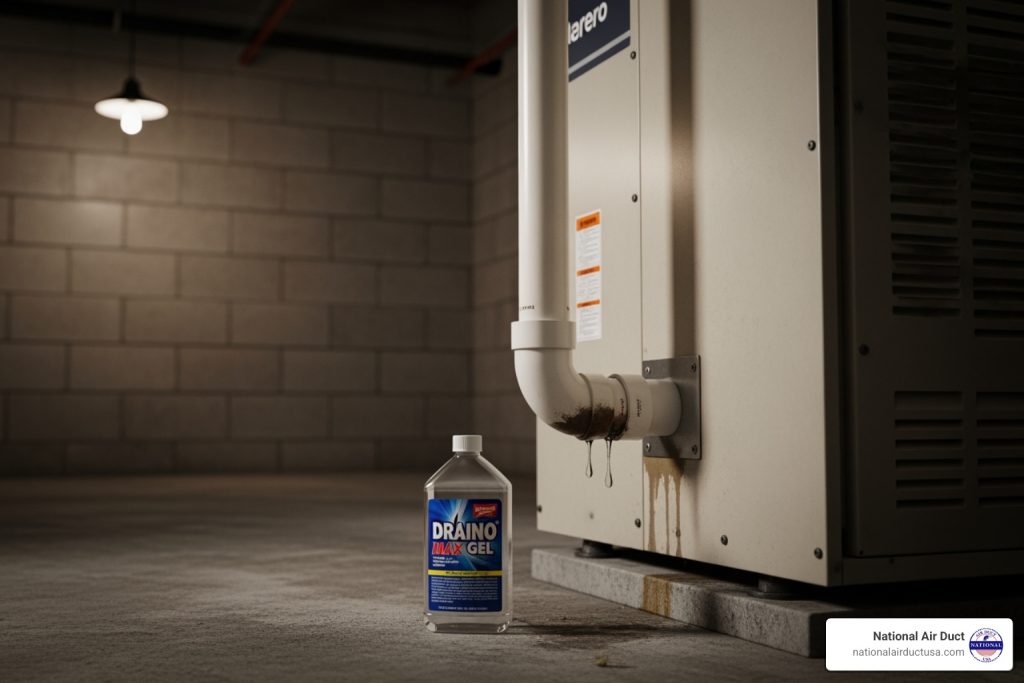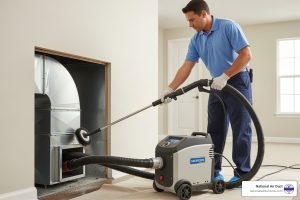Why Your HVAC Drain Line Needs Regular Attention
An HVAC drain cleaner keeps the narrow condensate line inside your air-conditioning system free of clogs, slime and algae. By clearing that path, you stop water from backing up, ruining drywall, and feeding mold that circulates through your vents.
Quick options at a glance:
- Liquid cleaners – pour 8 oz, wait 20 min (e.g., PURAFILTER 2000, about $9)
- Enzymatic treatments – non-corrosive bacteria that protect for up to 90 days
- Automated systems – set-and-forget devices like iFLO (~$99)
- DIY basics – distilled vinegar or a mild bleach mix
- Manual tools – drain snakes or a wet/dry vac for instant results
Left unchecked, Zoogloea (the sticky bio-film technicians call “drain slime”) can block the line in weeks. One overflow can translate into thousands in repairs and months of musty odors.
Spending a few dollars and five minutes every season is far cheaper than paying for water-damage restoration.

Why a Clogged AC Drain Line is a Serious Problem
Your AC system works hard to keep your home comfortable, but there’s one small component that can bring everything crashing down – literally. A clogged condensate drain line might seem like a minor hiccup, but it’s actually a ticking time bomb that can wreak havoc on your home, health, and bank account.
Here’s what happens when that innocent-looking drain line gets blocked with slime and debris.
Water damage strikes first and fast. Every hour your AC runs, it pulls moisture from the air and sends it down that drain line. When the line clogs, all that water has nowhere to go except into your home. We’re talking about gallons of water that can seep through ceilings, soak into walls, and flood floors.
The aftermath isn’t pretty – warped hardwood, ruined drywall, damaged insulation, and water stains that seem to appear out of nowhere. What started as a $10 HVAC drain cleaner problem suddenly becomes a $5,000 restoration nightmare. Trust us, we’ve seen homeowners learn this lesson the hard way.
Mold and mildew growth follows close behind the water damage. That standing water in your drain pan becomes a five-star resort for fungus. These unwelcome guests don’t just stay put – they release spores that get sucked right into your HVAC system and blown throughout your entire home.
The musty smell hits you first. Then comes the visible growth around vents and on walls. Before you know it, you’re dealing with a full-blown mold problem that makes your home feel more like a swamp than a sanctuary.
Poor indoor air quality becomes inevitable once mold takes hold. Every time your system kicks on, it’s essentially spraying mold spores into the air you breathe. For family members with allergies or asthma, this turns their own home into a health hazard.
Even healthy people start noticing symptoms – scratchy throats, stuffy noses, and that general feeling of being under the weather. At National Air Duct USA, we’ve seen how quickly a clogged drain can transform a comfortable home into an unhealthy environment.
Reduced system efficiency means your energy bills start climbing. When water backs up, your AC has to work overtime to remove humidity from your home. It’s like asking someone to run a race while carrying a heavy backpack – everything becomes harder and takes more energy.
Your system runs longer cycles, struggles to reach the set temperature, and burns through electricity like there’s no tomorrow. That monthly energy bill becomes a painful reminder that something’s wrong.
Costly repairs and system shutdowns deliver the final blow. Most modern AC units have safety switches that shut down the entire system when water levels get too high. While this prevents catastrophic flooding, it leaves you sweating in a hot house, usually on the hottest day of the year.
Emergency HVAC calls aren’t cheap, especially when you’re competing with every other homeowner whose system just failed. A simple drain cleaning that could have prevented the whole mess suddenly becomes a several-hundred-dollar emergency service call.
The good news? All of these problems are completely preventable with regular maintenance and the right HVAC drain cleaner. A little attention now saves you from major headaches later.
Types of HVAC Drain Cleaner Solutions
When your AC starts acting up because of a clogged drain line, you’ve got several weapons in your arsenal. Think of it like choosing the right tool for the job – sometimes you need a gentle touch, other times you need to bring out the big guns.
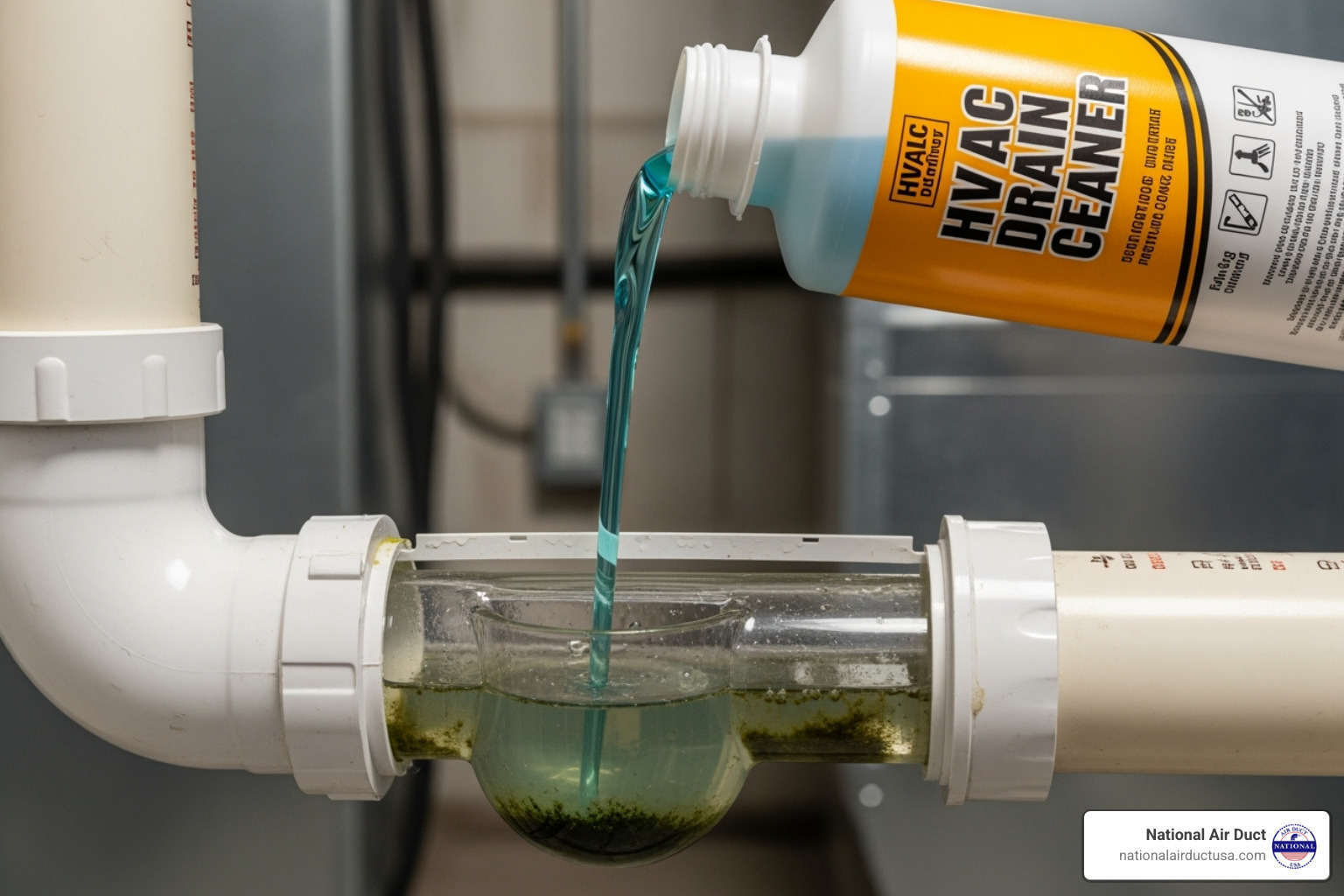
Let’s walk through your options, from the simplest pour-and-go solutions to high-tech systems that practically think for themselves.
Chemical and Enzymatic Liquid Cleaners
Liquid cleaners are the workhorses of the HVAC drain cleaner world. You’ll find two main types on the market, and understanding the difference can save you time, money, and maybe even your PVC pipes.
Chemical cleaners pack a serious punch. Products like Hercules Sizzle use virgin hydrochloric acid with corrosion inhibitors to dissolve tough mineral deposits and scale buildup. These cleaners work fast – think of them as the power washers of drain cleaning. They’re particularly good at breaking down inorganic deposits like carbonates and sulfates that can turn your drain line into a rock-hard mess.
But here’s where things get interesting. Enzymatic and probiotic cleaners take a completely different approach. Products like PURAFILTER 2000, Nu Line AC Drain Line Cleaner, and PowerZyme contain beneficial bacteria or enzymes that literally eat the organic slime and scum in your drain line. It’s like having a microscopic cleanup crew working around the clock.
The beauty of enzymatic cleaners lies in their gentleness. They’re typically safe for PVC pipes – which is crucial since most HVAC drain lines use PVC. These cleaners keep working long after you pour them in, with some products like Nu Line providing protection for up to 90 days.
Chemical cleaners work faster but require serious safety precautions. You’ll need gloves, eye protection, and good ventilation. Enzymatic cleaners are much more forgiving – you could probably drink some of them (though we don’t recommend it!). The trade-off is that enzymatic cleaners need more time to tackle severe clogs.
One critical point: never use regular household drain cleaners on your HVAC system. Those harsh chemicals can damage your drain pan, PVC pipes, and even your evaporator coils. Stick to products specifically designed for HVAC systems.
View a product Safety Data Sheet
Solid Treatments: Tablets and Strips
Think of tablets and strips as your preventative maintenance team. These slow-release treatments are designed to stop problems before they start, rather than fix existing disasters.
The concept is beautifully simple. You drop a tablet or place a strip directly into your drain pan. As condensate water drips down during normal AC operation, it slowly dissolves the treatment, releasing cleaning agents that prevent slime, mold, and algae from taking hold.
The convenience factor is huge. Once you place a tablet, you can forget about it for months. Many products provide continuous protection while also controlling those musty odors that signal trouble brewing in your drain line.
But here’s the reality check: tablets and strips are prevention, not cure. If your drain line is already backing up and your AC is shutting down, a tablet isn’t going to save the day. You’ll need to clear the existing clog first with a liquid cleaner or mechanical method, then use tablets to prevent future problems.
Manual and Mechanical Tools
Sometimes you need to get your hands dirty – literally. Mechanical methods give you immediate results when chemicals just aren’t cutting it.
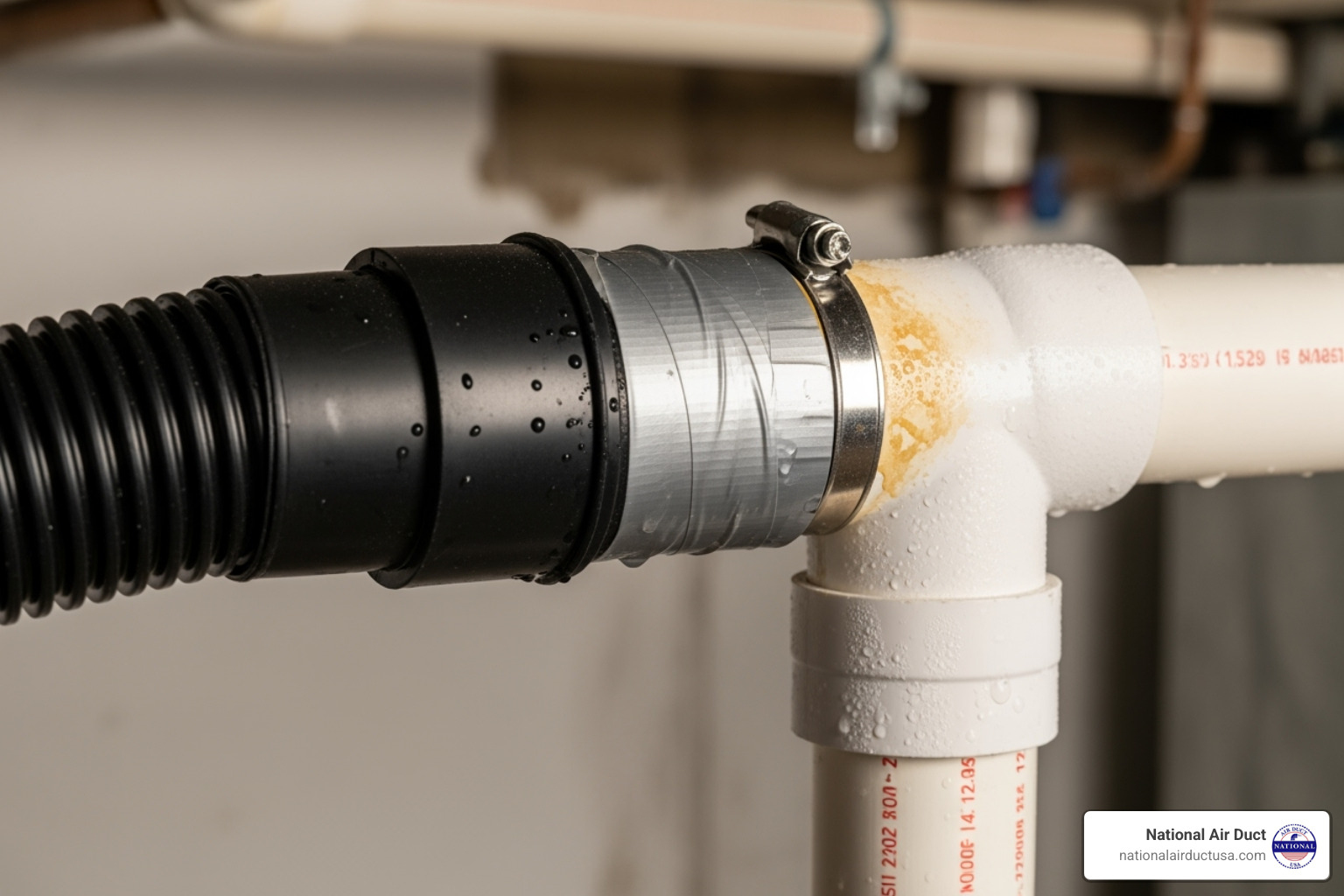
Drain snakes and brushes work great for clogs near the access point. These flexible tools let you physically break apart or pull out the slimy buildup. It’s satisfying work, though it can get messy.
The wet/dry vacuum method is a game-changer for many homeowners. Connect your shop vacuum hose to the outside end of your drain line and create powerful suction. When done right, you’ll pull out impressive slugs of slime and debris. Some specialized tools like the AC Condensate Drain Line Cleaner Tool are designed specifically for this process, promising to clear clogs in “30 seconds or less.”
These mechanical methods are completely chemical-free and give you instant feedback – you can see exactly what you’re pulling out of your system. The downside? It’s messy work, and you might not reach clogs deep in the line or in hard-to-access areas. Use too much force, and you risk damaging the line itself.
Automated Cleaning Systems
Welcome to the future of HVAC maintenance. Automated systems like the iFLO represent the ultimate in set-it-and-forget-it convenience.
These systems install once and then automatically dispense non-corrosive cleaning solution into your drain line at regular intervals – typically every two weeks. The iFLO system even includes smart detection to monitor for potential issues and send you alerts before problems become emergencies.
The peace of mind factor is enormous. No more remembering to clean your drain line, no more emergency shutdowns during heat waves, no more water damage from overflowing drain pans. The system maintains your drain line consistently, which improves overall system efficiency and keeps your indoor air cleaner.
The investment is significant – the iFLO system costs $99 upfront, plus ongoing costs for cleaning solution refills or subscription services like their Protection Plus at $9.99 per month. But when you consider the cost of emergency HVAC repairs or water damage cleanup, automated systems can pay for themselves quickly.
Installation is designed to be DIY-friendly for most homeowners, though you’ll want to read the instructions carefully. Even with automation, extremely unusual clogs might still require manual intervention, but these situations are rare with consistent preventative maintenance.
The right HVAC drain cleaner choice depends on your situation. Are you dealing with an active clog that needs immediate attention? Go with liquid cleaners or mechanical methods. Want to prevent future problems? Tablets or automated systems are your friends. Most homeowners find success with a combination approach – using liquid cleaners for occasional deep cleaning and tablets for ongoing prevention.
Best Practices for Using an HVAC Drain Cleaner and Preventing Clogs
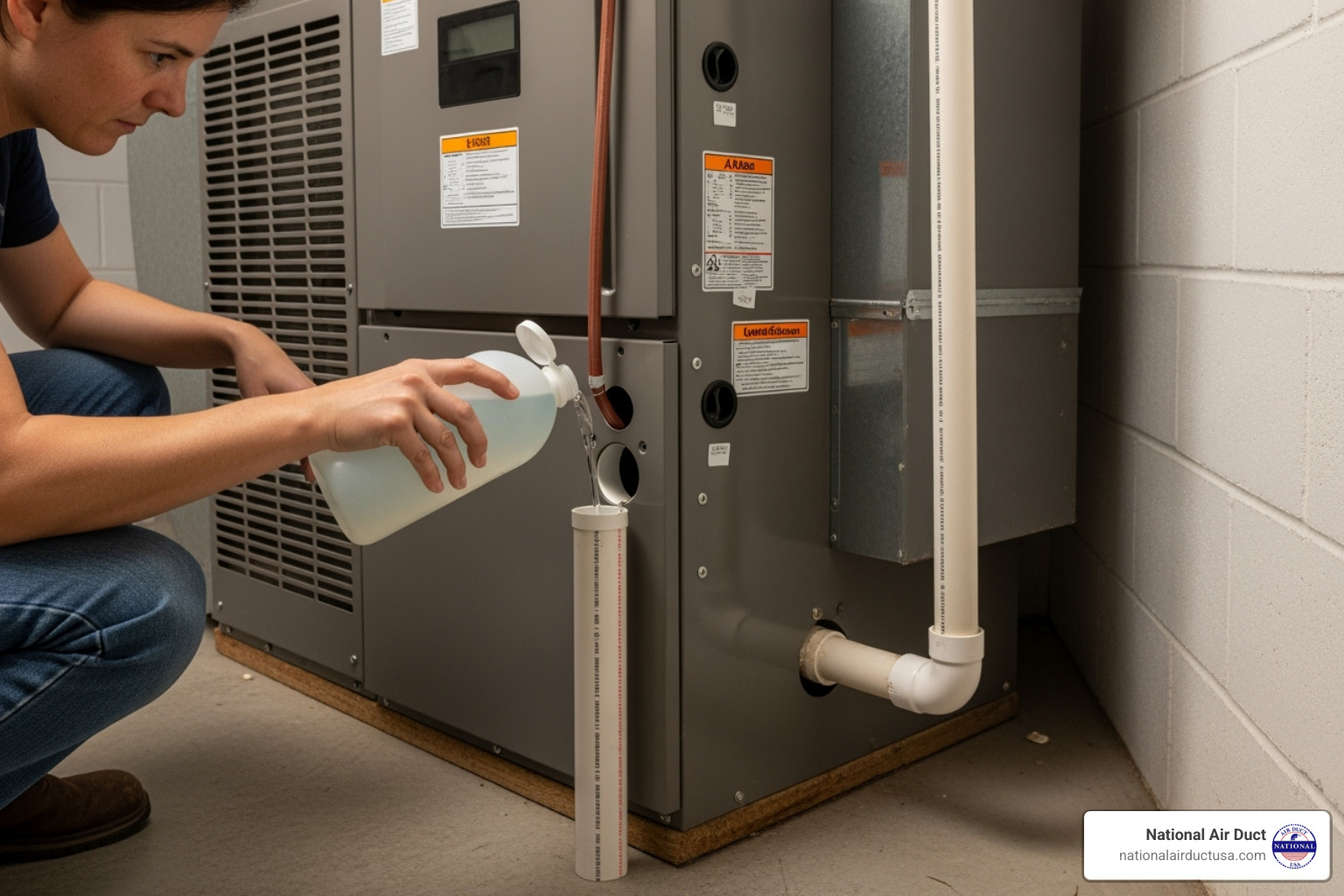
Regular, low-effort upkeep keeps your drain line—and the rest of your HVAC system—running at peak efficiency.
How Often to Clean and Signs of a Clog
Most homes do well with a quarterly cleaning. In very humid parts of New York, monthly is safer; in drier seasons you can stretch to every change of season.
Trust your senses between cleanings:
- Musty odors from the vents
- Standing water in or around the air handler
- Reduced cooling performance or unexpected shutdowns
All point to restricted drainage that needs attention right away.
A Guide to Choosing the Right HVAC Drain Cleaner
Ask first: are you preventing trouble or clearing a blockage?
- For prevention, enzymatic or probiotic liquids such as PURAFILTER 2000 coat the pipe and keep working for up to 90 days.
- For an existing clog, combine a wet/dry vacuum with an enzymatic flush—or, if time is critical, use a shop-vac alone for instant flow.
A $10 bottle four times a year (~$40) is a bargain compared with a single $300 emergency call or large-scale water repairs.
Always confirm the cleaner is PVC-safe and never pour household drain openers into your condensate line.
More info about how to disinfect HVAC system
DIY Natural Cleaning Methods
- Distilled vinegar – 1/4 cup straight into the access port every few weeks
- Diluted bleach – equal parts bleach and hot water (avoid if you have a condensate pump)
- Hot-water flush – follow any cleaner with very hot tap water
Wear gloves, ventilate the space and never mix products. Natural methods are great for upkeep but won’t cut through months of hardened buildup—call a professional if the line stays slow.
Frequently Asked Questions about HVAC Drain Cleaners
We get a lot of questions from homeowners about maintaining their HVAC drain lines. After years of helping families across New York improve their indoor air quality, we’ve noticed the same concerns come up again and again. Let’s tackle the most common ones with straight answers that can save you time, money, and headaches.
Can I use a regular household drain cleaner on my HVAC line?
Absolutely not! This is probably the most dangerous mistake we see homeowners make, and we can’t stress this enough. That bottle of drain cleaner under your kitchen sink is your HVAC system’s worst enemy.
Here’s the thing: household drain cleaners are chemical warriors designed for tough kitchen and bathroom clogs. They contain harsh ingredients like lye or sulfuric acid that can literally melt through hair and grease. Your kitchen pipes can handle this because they’re made of stronger materials like copper or cast iron.
But your HVAC drain cleaner needs are completely different. Your condensate line is made of PVC plastic, which might as well be tissue paper when it comes to these harsh chemicals. We’ve seen homeowners accidentally melt their drain lines, create dangerous leaks, and even damage expensive evaporator coils – all from trying to save a few dollars with the wrong product.
The chemical reactions from household cleaners can also generate enough heat to warp your drain pan or corrode your condensate pump. What starts as a $10 quick fix can quickly become a $1,000 repair nightmare.
HVAC drain cleaners are specially formulated to handle that slimy buildup without destroying your system. They’re gentler on your equipment but tough on the specific type of gunk that grows in air conditioning systems.
What’s the ‘slime’ in my AC drain line?
That gross, slimy mess clogging your drain line actually has a scientific name: Zoogloea. Don’t let the fancy name fool you – it’s basically nature’s way of turning your drain pan into a petri dish.
Think of it as a perfect storm of nastiness. Your AC pulls moisture out of the air, creating the ideal breeding ground for bacteria and mold. Then you add dust, pet hair, skin cells, and all the other microscopic stuff floating around your home. Mix in some darkness and constant moisture, and just like that, you’ve got yourself a thriving ecosystem of slime.
This isn’t just regular dirt that you can rinse away. Zoogloea is alive and sticky. It clings to your drain line walls like glue, growing thicker over time until water can’t flow through anymore. The bacteria feed on all that organic matter, creating more slime as they multiply.
The really unpleasant part? This living slime produces those musty, moldy odors that get pumped throughout your home. Every time your AC runs, you’re potentially breathing air that passed over this bacterial playground.
That’s why a quality HVAC drain cleaner with enzymes or probiotics works so well – it actually breaks down this biological buildup at the source, rather than just trying to wash it away.
When should I call a professional for a clogged drain?
Sometimes DIY solutions and store-bought HVAC drain cleaners just aren’t enough. We always encourage homeowners to try simple maintenance first, but there are definitely times when it’s smart to call in the experts.
Persistent clogs are usually the first red flag. If you’ve tried multiple cleaning methods and that drain line keeps backing up, you’re dealing with something more stubborn than typical slime buildup. Sometimes the clog is deep in the line where your cleaning solution can’t reach, or there might be a structural issue causing repeated blockages.
Water damage means it’s time to stop experimenting and call for help immediately. If you’re seeing water stains on your ceiling, walls, or floors – or worse, active dripping – the situation has moved beyond a simple maintenance issue. We can assess how extensive the damage is and prevent it from getting worse while we clear the clog.
Inaccessible drain lines are another common reason to call professionals. Not every homeowner can safely reach their drain line access point, especially if it’s in a cramped attic or crawl space. We have the tools and experience to work in tight spaces without damaging your system.
The smell test is important too. If you’re dealing with strong, persistent moldy odors that don’t go away after cleaning, the problem has likely spread beyond just the drain line. Mold on your evaporator coils or in your ductwork requires specialized equipment and knowledge to remove safely.
Here are the clear signs it’s time to call National Air Duct USA: water actively overflowing from your drain pan, significant water stains or ceiling leaks, strong musty odors that won’t go away, your AC frequently shutting itself off, no water draining outside during humid weather, visible mold growth on HVAC components, gurgling sounds from the drain with no water flow, or simply feeling uncomfortable working on your system yourself.
A clogged drain line is often just one symptom of a larger maintenance need. As NADCA-certified professionals, we always look at your entire HVAC system. Sometimes what looks like a simple drain problem is actually pointing to issues with your coils, air handler, or ductwork that need professional attention.
Don’t feel bad about calling for help – we’d rather fix a small problem now than see you dealing with major water damage or health issues later.
Conclusion: Keep Water Flowing and Air Clean
A clear condensate line protects your drywall, your wallet, and your lungs. For most homes, a $10 HVAC drain cleaner used each quarter is all it takes.
Pick the method that matches your style—enzymatic liquids, slow-release tablets, an automated iFLO unit, or just a vinegar flush—and stay consistent. Preventative care always costs less than an emergency call when your AC quits on a 95 °F day.
If clogs keep returning, water is already spilling, or mold is visible, call the NADCA-certified team at National Air Duct USA. We’ll inspect, clean, and restore your entire HVAC system so you can breathe easier again.
Learn more about how to fully disinfect HVAC system

